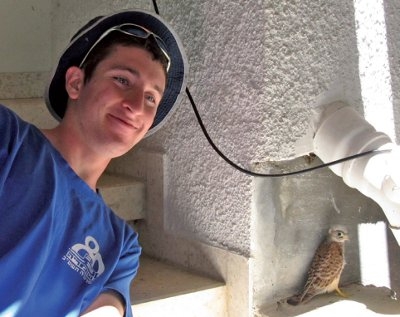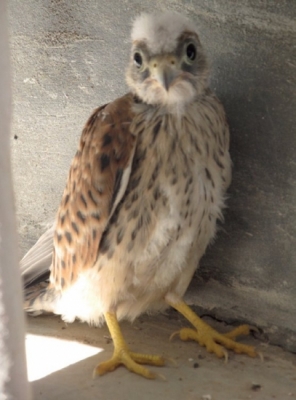Chicks of a Lesser Kind
Every morning for the last two weeks, I have been woken up around 6 am by the high-pitched squawking of a large number of chicks whose parents decided to roost in the roof of my kibbutz abode - a block of four apartments, two up, two down.
What began as one nest a few years ago has developed into five, attesting to the enormous effort made by bird lovers of the kibbutz kind who closely follow the development of the lesser kestrels (baz adom in Hebrew).
The crack of dawn racket stops only after the chicks receive their small lizard or worm breakfast from extremely overworked parents. Unfortunately, the well-fed and adventurous chicks often try to leave the nest a wee bit before Mother Nature has completed her developmental skills program, resulting in many falling to the ground from the rooftops – and with a large number of kibbutz cats on the prowl, their chances of survival are minimal.
The lesser kestrels are a relatively rare and endangered species, so every chick saved is another notch in the belt of success of a number of projects to increase their numbers throughout Israel.
The Lesser Kestrel Project of the Megiddo Regional Council and the Society for the Protection of Nature in Israel (SPNI) involves kibbutzim and moshavim in the Megiddo area – including my own, Mishmar HaEmek.
Cameras have been placed in buildings frequented by the lesser kestrels in some of the rural communities. Two regional schools also took on the fight for lesser kestrel survival. The aim is to develop community awareness – particularly to decide what to do with those chicks that fall out of their nests. This is not a small number I have recently discovered, with three chicks having been saved over the same number of days either from my veranda full of potted plants or from my front doorstep. With two upstairs neighbors - furry felines (who from time to time dump dead mice and bits and pieces of birds on my front porch) constantly on the prowl, the survival of those particular chicks is due entirely to the quick thinking of my neighbor, 16 year-old Daniel Shamis – whose parents own the cats – and who each time calls in the kibbutz 'fallen fledgling rescuer' Ron Tzur whilst staying on guard until Ron arrives.
Ron, a member of Kibbutz Mishmar HaEmek, heads the local rescue team for the fallen chicks. A computer engineer in charge of information security in the kibbutz industry, TAMA, the former biology teacher is also in charge of cameras that have been placed in a number of the local communities in order to follow the progress of the lesser kestrel. The camera and computer equipment were donated to the regional project by TAMA as one of their community-related projects and Ron controls these strategically placed cameras from home-base in Mishmar HaEmek.
Born in Kibbutz Givat Oz, a few kilometers from Mishmar HaEmek and near the Green Line and West Bank Palestinian villages, Ron switched kibbutzim after marrying a daughter of the neighboring kibbutz. However, since the project to protect the lesser kestrel was founded, the two kibbutzim in which there has been a huge increase in the number of nests and newborn chicks every year are Givat Oz and Mishmar HaEmek.
"The lesser kestrels build their nests under the roof tiles wherever they can find the smallest opening to allow them to do this. Often humans refuse to put up with the mess they create when building the nests or the noise when the chicks hatch, and so they close up the openings. For the lesser kestrel, the height is important, because it is protective and it is difficult for cats or other birds and animals to get to their eggs and chicks," explains Ron.
"The chicks usually return to the place where they were born a year later to build their own nests, and the fact that this region is now so successful in attracting them to do just that also attests to the ecological quality of this mostly agricultural area. Here they find sufficient food, and because we ensure that our surroundings stay as pollution-free as possible, we are successfully meeting the needs of nature."
The period of nesting and incubation of chicks takes around two weeks. In the last ten days, Ron Tzur has already come to the rescue of eight fallen chicks. He, his wife and three children take it in turns to feed the chicks every two hours for the first 24 hours before taking them to a Zichron Yaacov bird sanctuary.
"This time of year (June) we always have minced meat in the freezer," said Ron with a laugh.
The Megiddo Regional Lesser Kestrel Project has fostered the largest population of the species in Israel and the future looks bright for both birds and those carefully watching them, either through the secretly installed cameras or as they fly in and out of the rooftops.
In the days when the species was more common, the old stone and tiled-roof buildings of the Musrara neighborhood in Jerusalem were a favored nesting ground of the lesser kestrels. However, once those buildings were renovated and modernized and rooftops no longer offered the open spaces between tiles as they had in the good old days, the kestrels found no place to build a home and more or less disappeared from the landscape.
An educational project was also started in that neighborhood, nesting boxes were installed and in 1999 it became one of Time Magazine's "Heroes of the Planet" winners. At that time, the project brought together Jewish children from Jerusalem with peers from Jericho, also a favored spot of the birds at nesting time.
Asked if the lesser kestrels' return to the area had spawned any cooperation with the nearby – certainly as the bird flies – West Bank city of Jenin, Ron Tzur replied that unfortunately it had not.
"However, there's a great deal of cooperation between Jordan and Israel in connection with birds of all species and, hopefully, we will be able to work with the Palestinians in our region in the not too distant future," said Ron, the savior of Mishmar HaEmek's fallen fledglings.









Comments